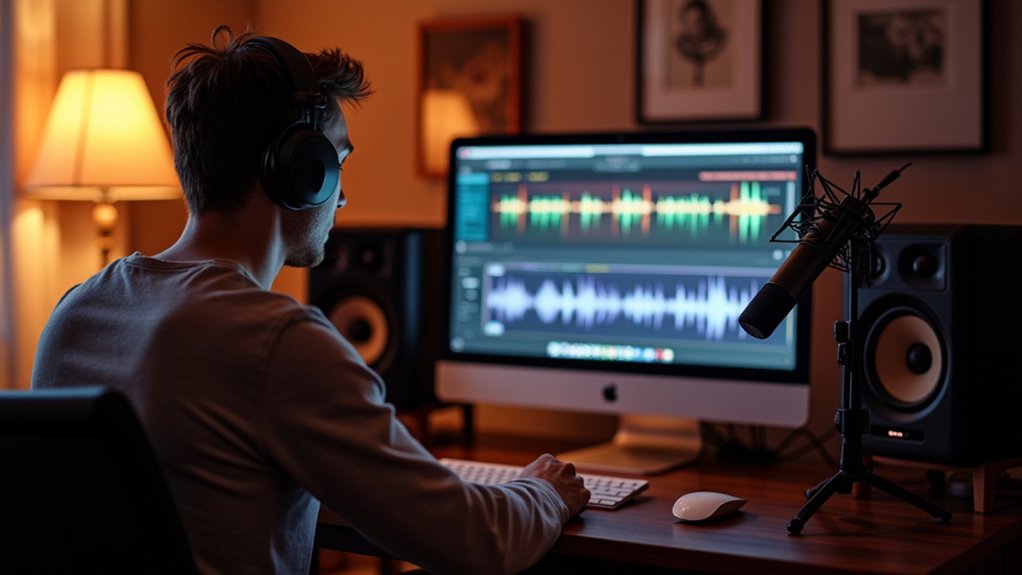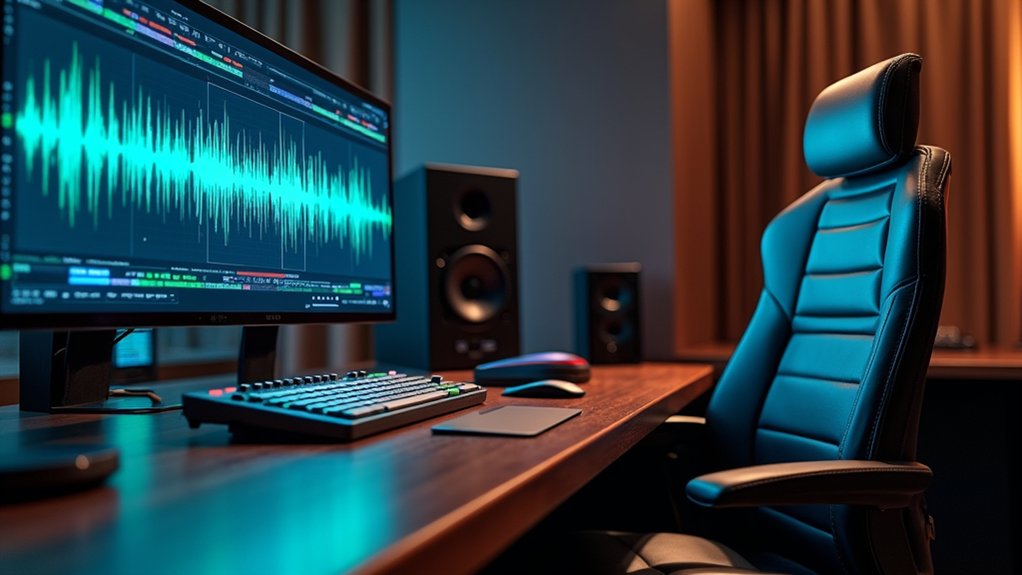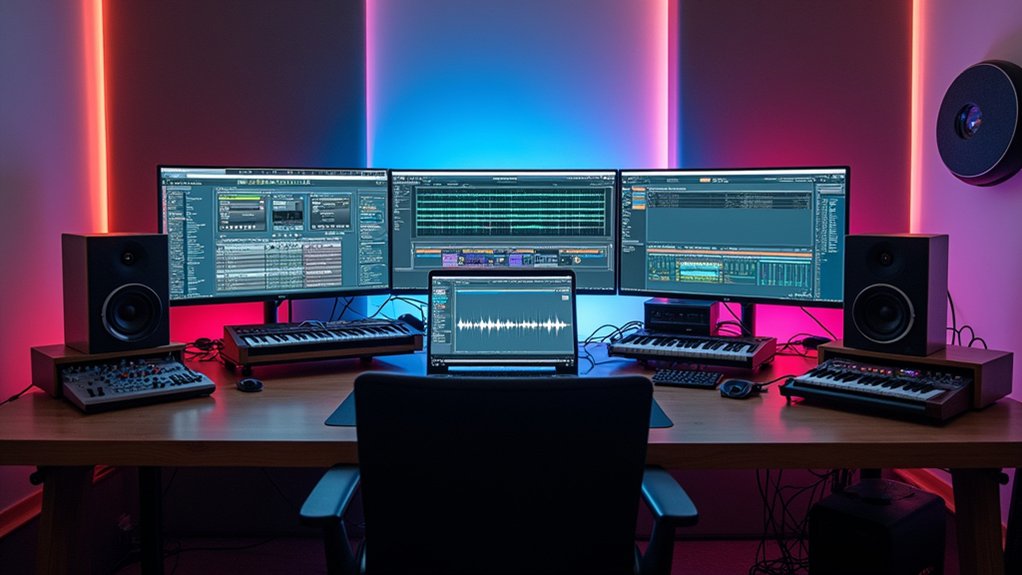Ocenaudio excels with a user-friendly interface, low learning curve, and real-time effect previews, making it ideal for straightforward audio editing and quick workflows. Audacity, however, provides expansive editing tools, multi-track capability, and broader plugin support, suiting advanced users and complex projects. Both are free and cross-platform, but Audacity’s robust community and features favor professional needs while Ocenaudio prioritizes simplicity and efficiency. Further comparison will clarify which solution fits specific technical and creative requirements.
Key Takeaways
- Ocenaudio offers a simpler, more intuitive interface ideal for beginners or quick edits, while Audacity suits users needing advanced features and multi-track editing.
- Audacity provides a wider range of built-in effects, plugin support, and detailed editing tools for complex audio projects.
- Ocenaudio excels in real-time effects preview and non-destructive editing, making it efficient for basic tasks and fast workflows.
- Audacity has stronger community support, extensive tutorials, and better resources for troubleshooting or learning advanced techniques.
- Both are free and cross-platform, but Ocenaudio is more lightweight, while Audacity handles larger, multi-track projects despite higher resource usage.
Overview of Ocenaudio
Ocenaudio is a free, cross-platform audio editor designed for streamlined recording and precise file manipulation across Windows, macOS, and Linux environments.
The software delivers efficient audio editing through a user-friendly interface, which lowers the entry barrier for both novices and users seeking straightforward functionality.
Ocenaudio supports VST plugin integration, facilitating the application of a diverse array of audio effects and signal processing options directly within the editing workflow.
Real-time effects previewing is a core feature, allowing users to audition modifications instantly and commit only when satisfied, thereby optimizing editing accuracy.
Non-destructive editing guarantees that changes do not overwrite the original source, preserving data integrity.
Additionally, Ocenaudio excels in handling large audio files without compromising performance, making it suitable for rapid, reliable audio editing tasks.
Overview of Audacity
Audacity stands as a robust, open-source audio editor and recorder, offering cross-platform compatibility with Windows, macOS, and Linux. Its versatility is demonstrated through support for a wide array of audio formats, such as WAV, AIFF, and MP3, streamlining both import and export workflows. The software’s multi-track editing capabilities allow users to manage complex audio projects by layering, synchronizing, and editing multiple tracks simultaneously. Audacity’s toolkit includes built-in audio effects like noise reduction and pitch correction, further enhanced by extensive plugin support for expanded functionality. While its reliability and thorough feature set make it suited for advanced editing tasks, new users may encounter a steep learning curve, given its powerful toolset and a user interface that can appear dated by modern standards. Audacity is known for advanced audio editing capabilities, such as pitch shifting and time stretching, which appeal to users seeking detailed manipulation options.
User Interface and Usability
When comparing layout and navigation, Ocenaudio offers a streamlined interface that emphasizes ease of use, while Audacity presents a more traditional design with customizable elements.
Ocenaudio’s minimal learning curve benefits users seeking immediate productivity, whereas Audacity’s interface, though less intuitive for beginners, supports advanced workflows through its flexible workspace.
Both programs maintain cross-platform consistency, but differ markedly in how efficiently new users can access key features.
User interface design plays a pivotal role in determining workflow efficiency and overall usability for audio editing software. Ocenaudio distinguishes itself with a streamlined layout and navigation system, prioritizing ease of use and immediate accessibility. User reviews consistently note its intuitive controls and real-time effect previews, which enhance workflow and reduce steps for basic operations. In contrast, Audacity features a more traditional interface with a denser arrangement of tools and menus, reflecting its robust feature set. While Audacity allows workspace customization, its layout can appear cluttered, potentially hindering navigation for beginners. The following table outlines key differences:
| Feature | Ocenaudio | Audacity |
|---|---|---|
| Layout Clarity | High | Moderate |
| Navigation Ease | Streamlined | Menu-driven |
| Customization | Basic | Extensive |
| Real-Time Previews | Yes | Limited |
| User Review Ratings | Generally Positive | Mixed |
Learning Curve Comparison
Although both Ocenaudio and Audacity cater to digital audio editing, their approaches to user interface and usability yield distinctly different learning curves.
Ocenaudio’s user-friendly interface streamlines navigation, minimizing barriers for beginners and those prioritizing workflow efficiency. Real-time effect previews further simplify experimentation, reducing the intimidation often associated with audio editing.
In contrast, Audacity’s customizable workspace and broad suite of advanced features enable granular control, yet its less intuitive design may present challenges for new users. Despite extensive community support and abundant tutorials, the initial learning curve for Audacity remains steeper.
- Users new to editing may feel empowered by Ocenaudio’s accessible design.
- Audacity’s robust feature set can evoke both excitement and overwhelm.
- The choice between immediate usability and advanced features may shape user satisfaction.
Audio Recording Capabilities
Both Ocenaudio and Audacity provide robust audio recording capabilities, supporting a range of input devices such as microphones and mixers to facilitate versatile capture scenarios.
Users benefit from efficient workflows for initiating and managing audio recording sessions.
Ocenaudio distinguishes itself by integrating noise cancellation features, which enhance the clarity of the record and minimize unwanted background interference during capture.
Audacity, meanwhile, extends functionality by enabling users to digitize recordings from external media, making it particularly effective for those seeking to convert analog sources to digital formats.
Both applications deliver full-featured audio recording environments, ensuring users can reliably record high-quality sound.
Audacity’s intuitive interface may offer an advantage for beginners, streamlining the setup process and making audio recording accessible to a wider audience.
Editing Tools and Workflow
Following robust audio recording capabilities, the editing tools and workflow offered by Ocenaudio and Audacity reveal distinct strengths tailored to different production needs.
Ocenaudio boasts advanced selection tools and true non-destructive editing, empowering users to refine audio without compromising the original file. Its interface enables an efficient workflow, especially when managing large files or multiple projects simultaneously.
Audacity, meanwhile, supports extensive editing tools—cut, copy, paste, delete—and offers multi-track editing, making it a powerhouse for users handling complex arrangements. Remarkably, Audacity’s unlimited Undo/Redo fosters creative experimentation.
- Non-destructive editing in Ocenaudio protects original audio—instilling confidence in every edit.
- Audacity’s multi-track editing inspires ambitious, layered productions.
- Real-time previewing and seamless workflow in both tools boost productivity and creative assurance.
- Regularly saving of the project in Audacity is crucial to prevent data loss during complex editing processes.
Effects and Plugin Support
When comparing built-in effects, Audacity offers a broader array of tools such as noise reduction and pitch adjustment, supporting complex audio processing tasks. Both applications accommodate VST plugins, but Audacity extends compatibility to LADSPA, LV2, Nyquist, and Audio Units, providing greater flexibility. Ocenaudio emphasizes real-time effect preview and usability, whereas Audacity caters to advanced users requiring extensive plugin integration and layered effects processing. Audacity’s Loudness Normalization feature helps maintain consistent audio levels, ensuring that tracks remain balanced and free from distortion.
Built-In Effects Comparison
While Ocenaudio integrates essential effects such as spectral analysis and a suite of fundamental audio processing tools, Audacity distinguishes itself by offering a broader range of built-in effects, including advanced features like noise reduction and pitch correction.
Ocenaudio’s real-time preview capability streamlines workflow by allowing users to hear changes instantly, which can be vital for rapid editing and precise adjustments. Conversely, Audacity applies its built-in effects in a non-real-time manner, requiring users to render changes before hearing results. This can impact workflow efficiency for those needing immediate auditory feedback.
However, Audacity compensates by supporting a more extensive library of VST plugins, extending its feature set for advanced users.
- Real-time preview in Ocenaudio boosts editing confidence.
- Audacity’s vast built-in effects foster creative flexibility.
- Workflow speed varies dramatically between the two.
VST and Plugin Compatibility
Plugin compatibility plays a critical role in determining the flexibility and extensibility of audio editing software. Ocenaudio supports VST plugin integration, enabling users to expand their toolkit with a variety of effects. However, its plugin support is somewhat limited when compared to Audacity, which accommodates LADSPA, LV2, Nyquist, VST, and Audio Unit plug-ins. This broad compatibility allows for advanced features such as noise reduction and pitch correction, enhancing workflow efficiency for users requiring sophisticated processing. The following table summarizes plugin support across both editors:
| Feature/Format | Ocenaudio |
|---|---|
| VST Plugin | Yes |
| LADSPA Support | No |
| Audio Unit | No |
| Advanced Features | Limited |
| Plugin Variety | Moderate |
Audacity’s diverse plugin support gives it a clear advantage for advanced users seeking extensible editing options.
Multi-Track Editing Comparison
Although both Ocenaudio and Audacity are popular audio editing tools, their approaches to multi-track editing differ considerably regarding capability and workflow.
Audacity offers robust multi-track editing, allowing users to manipulate, mix, and apply effects to individual tracks. This advanced multi-track editing makes it suitable for users handling complex audio projects.
In contrast, Ocenaudio offers limited audio editing in the multi-track context, focusing on a user-friendly interface and real-time effects preview but lacking the depth required for intricate track arrangements.
Users seeking workflow efficiency and technical control should consider these distinctions:
- Audacity enables advanced multi-track editing, supporting complex mixing and individual track processing.
- Ocenaudio’s limited audio editing suits straightforward, single or simple multi-track tasks.
- Those needing scalability and flexibility in audio production will find Audacity’s feature set more accommodating.
- Pro Tools offers non-destructive editing, a feature that Audacity lacks, making it a preferred choice for professional users requiring advanced editing capabilities.
Performance With Large Files
When working with high-resolution audio, Ocenaudio demonstrates consistently efficient memory usage and minimal latency, even during intensive batch processing tasks.
In contrast, Audacity’s resource demands can increase considerably with larger projects, affecting processing speed and responsiveness.
Both platforms maintain broad format compatibility, but Ocenaudio’s streamlined architecture offers notable workflow advantages when managing extensive audio files.
Handling High-Resolution Audio
While both Ocenaudio and Audacity support a broad spectrum of audio formats suitable for high-resolution work, their performance with large files diverges markedly.
In the context of handling high-resolution audio, Ocenaudio stands out for its efficient processing and non-destructive editing, allowing users to manipulate large files seamlessly without lag or risk to original content.
In contrast, Audacity, despite its robust multi-track capabilities and thorough toolset, may encounter occasional slowdowns or instability when editing extensive high-resolution projects.
Users needing dependable performance with massive audio files may find Ocenaudio preferable for a streamlined workflow.
Consider the following critical points:
- Ocenaudio processes large, high-resolution files swiftly and reliably.
- Audacity’s toolset is extensive but can struggle with massive file sizes.
- Non-destructive editing in Ocenaudio enhances flexibility and safety.
Speed During Batch Processing
Batch processing performance distinguishes Ocenaudio as a tool engineered for efficiency with large audio files.
The software’s architecture supports efficient speed during batch processing, minimizing lag and maintaining a responsive user interface even when managing multiple extensive audio projects. Non-destructive editing further guarantees that original files remain intact, an advantage during automated batch operations.
Ocenaudio’s background processing capabilities allow complex and time-consuming tasks to proceed without disrupting user workflow, optimizing both performance and productivity.
In contrast, Audacity, while dependable for many editing tasks, can experience instability and slower speed during batch processing of large files, particularly on systems with limited resources.
This difference in performance makes Ocenaudio a preferred choice for users who prioritize efficient batch processing and streamlined handling of large-scale audio edits.
Memory Usage Efficiency
Although both Ocenaudio and Audacity are capable audio editors, significant differences emerge in memory usage efficiency, particularly when managing large files.
Ocenaudio’s architecture is optimized for low memory usage and stable performance, even with multiple large files open simultaneously. Its non-destructive editing approach guarantees that the original audio remains unaltered, minimizing memory overhead and maximizing workflow efficiency.
In contrast, Audacity can consume more memory due to its broader feature set, which may result in instability or crashes with complex or sizable projects.
Key differentiators in memory usage efficiency include:
- Ocenaudio’s non-destructive editing maintains performance without high memory costs.
- Audacity’s memory usage may spike during extensive editing, impacting stability.
- Ocenaudio is consistently responsive, even as project demands increase.
This distinction is significant for users handling large-scale audio work.
Supported Audio Formats
Format compatibility stands as a core strength for both Ocenaudio and Audacity, with each application supporting a broad spectrum of audio file types, including WAV, AIFF, and MP3.
This extensive support for import and export operations guarantees users can work efficiently across diverse production environments.
Ocenaudio supports seamless handling of multiple audio files and formats, streamlining analysis and editing tasks without unnecessary complexity.
Audacity, meanwhile, extends its versatility by accommodating various plugin formats—LADSPA, LV2, Nyquist, VST, and Audio Unit—enabling advanced processing and effect integration.
While Ocenaudio supports VST plugins for real-time effects during editing, its focus remains on usability and workflow fluidity across supported audio formats.
Both editors enable straightforward exporting, facilitating flexible audio distribution and project collaboration.
Platform Compatibility
How do Ocenaudio and Audacity measure up regarding platform compatibility for audio professionals? Both editors excel in cross-platform accessibility, supporting all major operating systems—Windows, macOS, and Linux. This guarantees that users are not restricted by hardware or OS, which is crucial for workflow efficiency in diverse production environments.
Ocenaudio stands out with a uniform graphical interface across platforms, reducing the learning curve and enabling seamless shifts. Audacity, equally cross-platform, maintains consistent functionality regardless of device.
Regular updates for both software keep them compatible with the latest OS versions, safeguarding performance and stability.
Key factors to take into account:
- Reliable support for major operating systems.
- Uniform cross-platform user experience.
- Continuous updates for peak platform compatibility.
These aspects directly impact workflow adaptability and technical precision.
Community Support and Resources
Beyond platform compatibility, the availability of community support and learning resources greatly shapes the user experience for audio professionals.
Audacity stands out with its robust community support, offering users extensive resources, including thorough tutorials, active forums, and a wealth of user-generated content. This depth of support allows users to efficiently troubleshoot issues, streamline workflows, and maximize feature utilization. Audacity also provides guidance on configuring audio settings to achieve superior sound quality, which is crucial for professional audio production.
In contrast, Ocenaudio, despite its intuitive interface, provides fewer resources and a smaller community, which may hinder users when seeking advanced solutions or guidance. The limited documentation and less active support network can impact workflow efficiency, particularly for complex tasks.
Pricing and Licensing
Both Ocenaudio and Audacity present compelling value propositions by being entirely free and open-source, removing financial barriers for users seeking robust audio editing capabilities. Their pricing model—zero cost—requires no paid licenses or subscriptions, making them attractive to professionals and hobbyists alike.
Users can download, install, and utilize the full functionality of each platform without encountering paywalls or feature restrictions. Licensing is straightforward, as both adhere to open-source standards, granting users flexibility to use, modify, or distribute the software.
Key factors that make their free and open-source audio approach emotionally resonant include:
- Complete access without financial commitment.
- Absence of licensing fees or trial limitations.
- Alignment with user empowerment and community-driven innovation.
This transparent pricing and licensing structure fosters efficient workflows and broad accessibility.
Pros and Cons Summary
While Ocenaudio distinguishes itself with a streamlined interface optimized for ease of use, Audacity offers a broader spectrum of advanced editing tools and multi-track capabilities, appealing to users with more complex requirements. Evaluating the pros and cons of each audio editor reveals clear distinctions in workflow efficiency and feature depth. Ocenaudio’s real-time effect previews and non-destructive editing facilitate rapid audio adjustments, especially for beginners or those handling large files. Conversely, Audacity’s robust plugin support, noise reduction, and multi-track editing tools are tailored for professional-grade audio editing, though its interface may seem intimidating to novices. Both are free and open-source, yet their target audiences diverge. GarageBand, by contrast, offers built-in virtual instruments and an intuitive design that is especially appealing to beginners in music production. The table below summarizes key pros and cons for both software:
| Ocenaudio Pros/Cons | Audacity Pros/Cons |
|---|---|
| User-friendly interface | Advanced editing features |
| Real-time effect preview | Multi-track support |
| Efficient with large files | Extensive plugin ecosystem |
| Lacks advanced effects | Steeper learning curve |
| Non-destructive editing | Robust noise reduction |
Frequently Asked Questions
Is Audacity the Best Audio Editor?
Evaluating whether Audacity is the best audio editor involves analyzing user experience, editing features, and audio formats supported. While robust and versatile, some users find workflow efficiency hindered by its interface and limited multitrack capabilities compared to newer alternatives.
Is There Anything Better Than Audacity?
When evaluating alternative audio editors, users may prioritize user friendly interfaces or advanced features comparison. Solutions like Reaper and Hindenburg offer specialized workflows and robust toolsets, potentially surpassing Audacity in technical precision, workflow efficiency, and feature analysis.
What Is the Best Audio Editing Tool?
Selecting the best audio editing tool depends on balancing audio editing features, user interface comparison, and platform compatibility. Some prioritize advanced features and plugin support, while others value an intuitive interface and efficient workflow across Windows, macOS, and Linux.
What Is the Disadvantage of Audacity?
The main disadvantages of Audacity include user interface issues that may impede workflow efficiency, limited effects compared to more advanced editors, and a steep learning curve, particularly for beginners, which can hinder effective utilization of its feature set.
Conclusion
In conclusion, both Ocenaudio and Audacity present robust free solutions for audio editing, each with distinct advantages. Ocenaudio excels in workflow efficiency and user-friendly interfaces, making it ideal for quick, non-destructive editing. Audacity, with its extensive feature set and plugin support, caters to users requiring advanced capabilities and community-driven development. The best choice ultimately depends on specific workflow needs, desired feature sets, and platform requirements, ensuring efficient audio production tailored to individual use cases.




